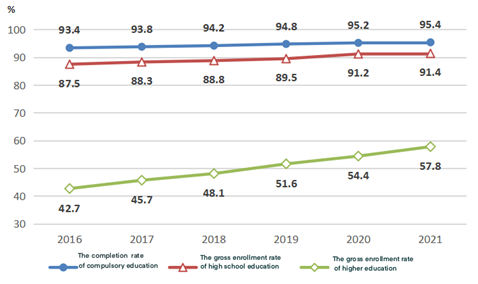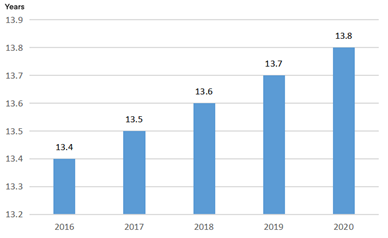Progress report on China's youth development


To show the progress in the implementation of the Medium and Long Term Youth Development Plan (2016-2025) (hereinafter referred to as the Plan) and according to the statistical monitoring outline of the Plan, the Central Committee of the Communist Youth League of China and the National Bureau of Statistics collected data in 2020 by coordinating relevant ministries and government departments and made comprehensive analysis on the changes of youth development in various areas by combining some historical figures.
The result shows that some indicators have reached the standard ahead of schedule along with the continuous and in-depth implementation of the Plan and the display of the effects.
1. Overview of Youth Population
According to the seventh national census in 2020, China's population of youth aged 14-35 was about 400 million, making up 28.4 percent of the total population. Combined with historical data, the youth population has seen a gradual decrease since 2000, when it peaked at 490 million. The figure fell by about 90 million in the two decades to 2020.

From a worldwide perspective, the proportion of young people in the world population and in some countries [1] has been declining since 1990. Among them, the decline in China, ROK and Japan is faster, and it is slower in the United Kingdom where the proportion is lower. The decline in the United States of America slowed down after 2000. It was after 2010 that India experienced a slow drop.
2. Implementation of the Plan in Various Areas
1) Ideology and Moral Integrity
Education has been carried out on Xi Jinping Thought on Socialism with Chinese Characteristics for a New Era, on ideals and convictions, and on core socialist values. Young people received ideological baptism from the study of the history of the Communist Party of China. They stand firm in their conviction of Marxism and socialism in historical references and in the national reality.
Courses of ideology and politics have been given more emphasis. From 2016 to 2020, ideological and political education in higher education institutions has been part of a credit-bearing course. For these compulsory courses, 16 credits are required for undergraduates, 8 for junior college students, 3 for postgraduate students, and 2 credits for doctoral students. In vocational schools 36 hours of these courses are maintained in each semester. While in high schools, 6 credits were readjusted for compulsory courses on ideology and politics and 0-4 credits were added as selective courses in 2020.
2) Education
Education coverage continues to expand. Since 2016, there has been a continuous rise in the completion rate of compulsory education, the gross enrollment rate of high school education, and the gross enrollment rate of higher education, reaching 95.2 percent, 91.2 percent, and 54.4 percent, respectively, in 2020. Among them, the gross enrollment rate of higher education achieved ahead of time in 2019 the goal of more than 50 percent set in the Plan.

The average years of education for newly increased labor force have grown steadily. Between 2016 and 2020, the number of years rose from 13.4 to 13.8 on average, achieving ahead of time the development goal of "more than 13.5 years" set in the Plan.

Education equity has been promoted steadily. During the 13th Five-Year-Plan period (2016-2020), the ratio of fiscal expenditure on education in GDP remained above 4 percent, and a financial aid system covering students in all levels of education has been established. In 2020, 85.8 percent of children of migrant workers studied in public schools or benefited from government purchase of private school service.


